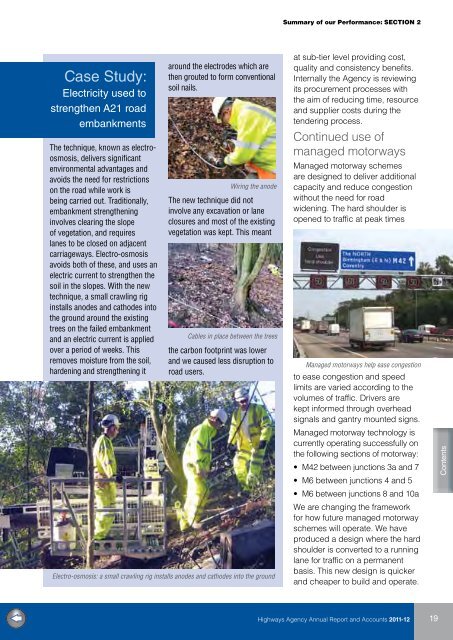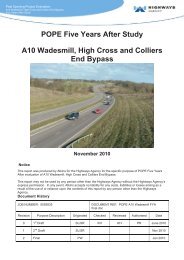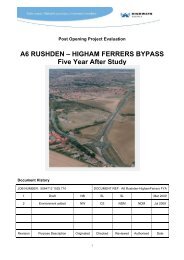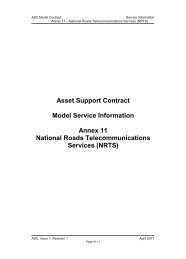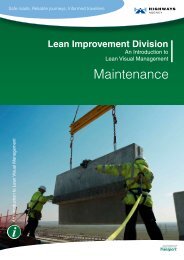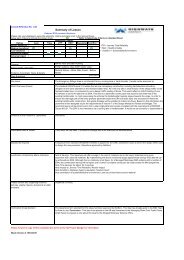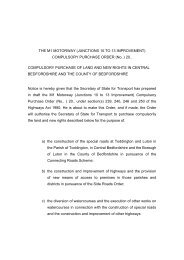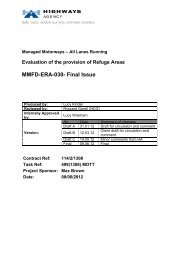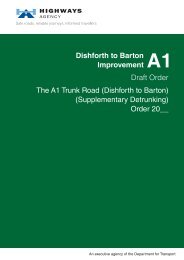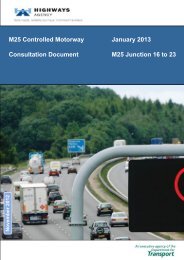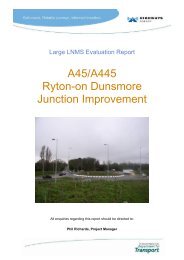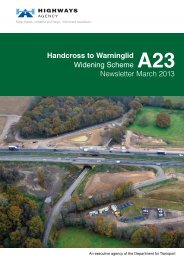Highways Agency Annual Report and Accounts 2011-2012
Highways Agency Annual Report and Accounts 2011-2012
Highways Agency Annual Report and Accounts 2011-2012
You also want an ePaper? Increase the reach of your titles
YUMPU automatically turns print PDFs into web optimized ePapers that Google loves.
Summary of our Performance: SECTION 2<br />
Case Study:<br />
Electricity used to<br />
strengthen A21 road<br />
embankments<br />
The technique, known as electroosmosis,<br />
delivers significant<br />
environmental advantages <strong>and</strong><br />
avoids the need for restrictions<br />
on the road while work is<br />
being carried out. Traditionally,<br />
embankment strengthening<br />
involves clearing the slope<br />
of vegetation, <strong>and</strong> requires<br />
lanes to be closed on adjacent<br />
carriageways. Electro-osmosis<br />
avoids both of these, <strong>and</strong> uses an<br />
electric current to strengthen the<br />
soil in the slopes. With the new<br />
technique, a small crawling rig<br />
installs anodes <strong>and</strong> cathodes into<br />
the ground around the existing<br />
trees on the failed embankment<br />
<strong>and</strong> an electric current is applied<br />
over a period of weeks. This<br />
removes moisture from the soil,<br />
hardening <strong>and</strong> strengthening it<br />
around the electrodes which are<br />
then grouted to form conventional<br />
soil nails.<br />
Wiring the anode<br />
The new technique did not<br />
involve any excavation or lane<br />
closures <strong>and</strong> most of the existing<br />
vegetation was kept. This meant<br />
Cables in place between the trees<br />
the carbon footprint was lower<br />
<strong>and</strong> we caused less disruption to<br />
road users.<br />
Electro-osmosis: a small crawling rig installs anodes <strong>and</strong> cathodes into the ground<br />
at sub-tier level providing cost,<br />
quality <strong>and</strong> consistency benefits.<br />
Internally the <strong>Agency</strong> is reviewing<br />
its procurement processes with<br />
the aim of reducing time, resource<br />
<strong>and</strong> supplier costs during the<br />
tendering process.<br />
Continued use of<br />
managed motorways<br />
Managed motorway schemes<br />
are designed to deliver additional<br />
capacity <strong>and</strong> reduce congestion<br />
without the need for road<br />
widening. The hard shoulder is<br />
opened to traffic at peak times<br />
Managed motorways help ease congestion<br />
to ease congestion <strong>and</strong> speed<br />
limits are varied according to the<br />
volumes of traffic. Drivers are<br />
kept informed through overhead<br />
signals <strong>and</strong> gantry mounted signs.<br />
Managed motorway technology is<br />
currently operating successfully on<br />
the following sections of motorway:<br />
• M42 between junctions 3a <strong>and</strong> 7<br />
• M6 between junctions 4 <strong>and</strong> 5<br />
• M6 between junctions 8 <strong>and</strong> 10a<br />
We are changing the framework<br />
for how future managed motorway<br />
schemes will operate. We have<br />
produced a design where the hard<br />
shoulder is converted to a running<br />
lane for traffic on a permanent<br />
basis. This new design is quicker<br />
<strong>and</strong> cheaper to build <strong>and</strong> operate.<br />
<strong>Highways</strong> <strong>Agency</strong> <strong>Annual</strong> <strong>Report</strong> <strong>and</strong> <strong>Accounts</strong> <strong>2011</strong>-12


